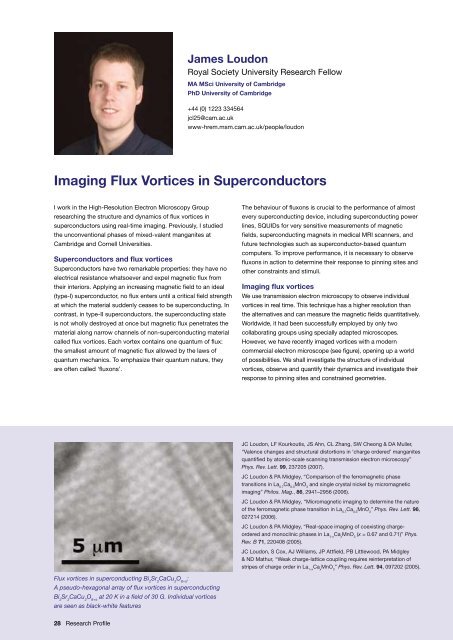Research Profile - Department of Materials Science and Metallurgy ...
Research Profile - Department of Materials Science and Metallurgy ...
Research Profile - Department of Materials Science and Metallurgy ...
Create successful ePaper yourself
Turn your PDF publications into a flip-book with our unique Google optimized e-Paper software.
James Loudon<br />
Royal Society University <strong>Research</strong> Fellow<br />
MA MSci University <strong>of</strong> Cambridge<br />
PhD University <strong>of</strong> Cambridge<br />
+44 (0) 1223 334564<br />
jcl25@cam.ac.uk<br />
www-hrem.msm.cam.ac.uk/people/loudon<br />
Imaging Flux Vortices in Superconductors<br />
I work in the High-Resolution Electron Microscopy Group<br />
researching the structure <strong>and</strong> dynamics <strong>of</strong> flux vortices in<br />
superconductors using real-time imaging. Previously, I studied<br />
the unconventional phases <strong>of</strong> mixed-valent manganites at<br />
Cambridge <strong>and</strong> Cornell Universities.<br />
Superconductors <strong>and</strong> flux vortices<br />
Superconductors have two remarkable properties: they have no<br />
electrical resistance whatsoever <strong>and</strong> expel magnetic flux from<br />
their interiors. Applying an increasing magnetic field to an ideal<br />
(type-I) superconductor, no flux enters until a critical field strength<br />
at which the material suddenly ceases to be superconducting. In<br />
contrast, in type-II superconductors, the superconducting state<br />
is not wholly destroyed at once but magnetic flux penetrates the<br />
material along narrow channels <strong>of</strong> non-superconducting material<br />
called flux vortices. Each vortex contains one quantum <strong>of</strong> flux:<br />
the smallest amount <strong>of</strong> magnetic flux allowed by the laws <strong>of</strong><br />
quantum mechanics. To emphasize their quantum nature, they<br />
are <strong>of</strong>ten called ‘fluxons’.<br />
The behaviour <strong>of</strong> fluxons is crucial to the performance <strong>of</strong> almost<br />
every superconducting device, including superconducting power<br />
lines, SQUIDs for very sensitive measurements <strong>of</strong> magnetic<br />
fields, superconducting magnets in medical MRI scanners, <strong>and</strong><br />
future technologies such as superconductor-based quantum<br />
computers. To improve performance, it is necessary to observe<br />
fluxons in action to determine their response to pinning sites <strong>and</strong><br />
other constraints <strong>and</strong> stimuli.<br />
Imaging flux vortices<br />
We use transmission electron microscopy to observe individual<br />
vortices in real time. This technique has a higher resolution than<br />
the alternatives <strong>and</strong> can measure the magnetic fields quantitatively.<br />
Worldwide, it had been successfully employed by only two<br />
collaborating groups using specially adapted microscopes.<br />
However, we have recently imaged vortices with a modern<br />
commercial electron microscope (see figure), opening up a world<br />
<strong>of</strong> possibilities. We shall investigate the structure <strong>of</strong> individual<br />
vortices, observe <strong>and</strong> quantify their dynamics <strong>and</strong> investigate their<br />
response to pinning sites <strong>and</strong> constrained geometries.<br />
JC Loudon, LF Kourkoutis, JS Ahn, CL Zhang, SW Cheong & DA Muller,<br />
“Valence changes <strong>and</strong> structural distortions in ‘charge ordered’ manganites<br />
quantified by atomic-scale scanning transmission electron microscopy”<br />
Phys. Rev. Lett. 99, 237205 (2007).<br />
JC Loudon & PA Midgley, “Comparison <strong>of</strong> the ferromagnetic phase<br />
transitions in La 0.7<br />
Ca 0.3<br />
MnO 3<br />
<strong>and</strong> single crystal nickel by micromagnetic<br />
imaging” Philos. Mag., 86, 2941–2956 (2006).<br />
JC Loudon & PA Midgley, “Micromagnetic imaging to determine the nature<br />
<strong>of</strong> the ferromagnetic phase transition in La 0.7<br />
Ca 0.3<br />
MnO 3<br />
” Phys. Rev. Lett. 96,<br />
027214 (2006).<br />
JC Loudon & PA Midgley, “Real-space imaging <strong>of</strong> coexisting chargeordered<br />
<strong>and</strong> monoclinic phases in La 1‐x<br />
Ca x<br />
MnO 3<br />
(x = 0.67 <strong>and</strong> 0.71)” Phys.<br />
Rev. B 71, 220408 (2005).<br />
JC Loudon, S Cox, AJ Williams, JP Attfield, PB Littlewood, PA Midgley<br />
& ND Mathur, “Weak charge-lattice coupling requires reinterpretation <strong>of</strong><br />
stripes <strong>of</strong> charge order in La 1–x<br />
Ca x<br />
MnO 3<br />
” Phys. Rev. Lett. 94, 097202 (2005).<br />
Flux vortices in superconducting Bi 2<br />
Sr 2<br />
CaCu 2<br />
O 8+ō<br />
:<br />
A pseudo-hexagonal array <strong>of</strong> flux vortices in superconducting<br />
Bi 2<br />
Sr 2<br />
CaCu 2<br />
O 8+ō<br />
at 20 K in a field <strong>of</strong> 30 G. Individual vortices<br />
are seen as black-white features<br />
28 <strong>Research</strong> <strong>Pr<strong>of</strong>ile</strong>

















